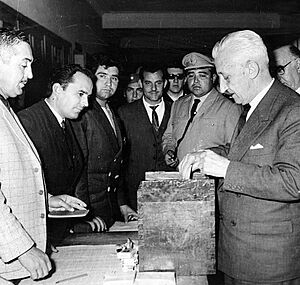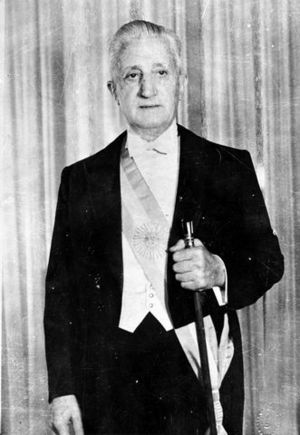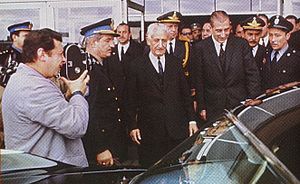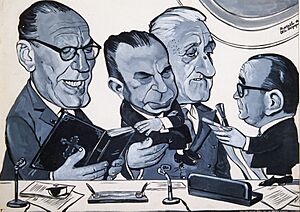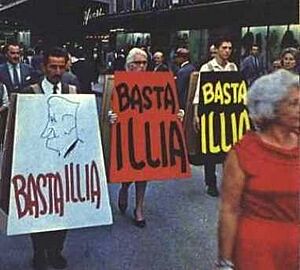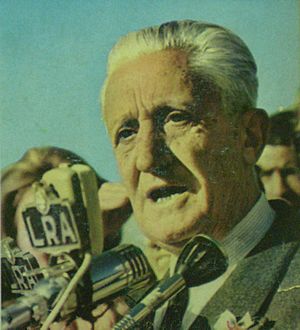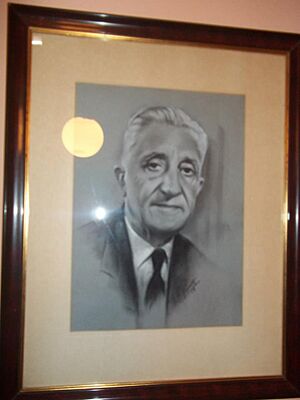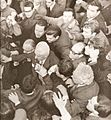Arturo Umberto Illia facts for kids
Quick facts for kids
Arturo Illia
OLSM, OM
|
|
|---|---|
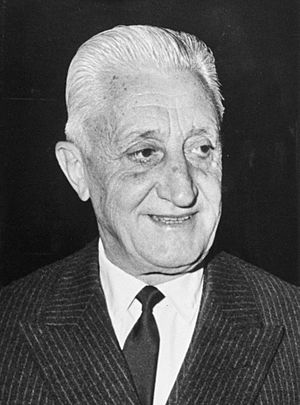
Illia, May 1965
|
|
| President of Argentina | |
| In office 12 October 1963 – 28 June 1966 |
|
| Vice President | Carlos Humberto Perette |
| Preceded by | José María Guido |
| Succeeded by | Juan Carlos Onganía |
| National Deputy | |
| In office 20 April 1948 – 30 April 1952 |
|
| Constituency | Córdoba |
| Vice Governor of Córdoba | |
| In office 17 June 1940 – 19 June 1943 |
|
| Governor | Santiago H. del Castillo |
| Preceded by | Alejandro Gallardo |
| Succeeded by | Asís Ramón |
| Provincial Senator of Córdoba | |
| In office 1 May 1936 – 24 April 1940 |
|
| Preceded by | Fidel Torres |
| Succeeded by | Nicolás Pedernera |
| Constituency | Cruz del Eje |
| Personal details | |
| Born |
Arturo Umberto Illia
4 August 1900 Pergamino, Buenos Aires, Argentina |
| Died | 18 January 1983 (aged 82) Córdoba, Argentina |
| Resting place | La Recoleta Cemetery, Buenos Aires |
| Nationality | |
| Political party | Radical Civic Union |
| Spouse |
Silvia Martorell
(m. 1939; died 1966) |
| Children | Emma Silvia Illia Martín Arturo Illia Leandro Hipólito Illia |
| Alma mater | University of Buenos Aires |
| Signature |  |
Arturo Umberto Illia (born August 4, 1900 – died January 18, 1983) was an Argentine politician and doctor. He served as the President of Argentina from October 12, 1963, to June 28, 1966. He was a member of the Radical Civic Union political party.
Illia became president after elections that were controlled by the Armed Forces. During this time, a political movement called Peronism was not allowed. The previous president, Arturo Frondizi, was also held captive.
During Illia's time as president, he focused on helping Argentina's industries grow. He spent a lot of money on education, about 23% of the national budget. This was the highest amount ever spent on education in Argentina's history. Under his leadership, fewer people were unemployed, and the country's debt to other countries went down. He also started a plan to teach more people to read and write. He passed important laws like the Minimum Wage law and the Medications Law.
Illia was known for being very honest. He lived most of his life in a simple home in Cruz del Eje, where he worked as a doctor. He never used his power for his own benefit. For example, he had to sell his own car while he was president. He also refused to use public money for his medical treatments. After his presidency, he continued to be active in politics. He even turned down the retirement benefits he was offered as a former president. He went back home to continue working as a doctor.
Contents
Biography

Arturo Umberto Illia was born in Pergamino, Buenos Aires. His parents, Emma Francesconi and Martín Illia, were immigrants from the Lombardy Region of Italy.
In 1918, he started studying at the School of Medicine at the University of Buenos Aires. That same year, he joined a movement called the Reforma Universitaria (University Reform). This movement began in Córdoba. It helped create a university system that was free, open, and less controlled by the Catholic Church. This reform changed higher education in Argentina and many other parts of Latin America.
As part of his medical studies, Illia worked at the San Juan de Dios Hospital in La Plata. He finished his degree in 1927.
In 1928, he met President Hipólito Yrigoyen, who was the leader of the UCR party. Illia offered to work as a doctor. Yrigoyen offered him a job as a doctor for the railroad in different parts of the country. Illia decided to move to Cruz del Eje, in Cordoba Province. He worked there as a doctor from 1929 until 1963. The only time he stopped was for three years (1940–1943) when he was the Vice-Governor of the province.
Family Life
On February 15, 1939, Arturo Illia married Silvia Elvira Martorell. They had three children: Emma Silvia, Martín Arturo, and Leandro Hipólito. Their son, Martín Illia, later became a member of Congress in 1995. He served until he passed away in 1999.
Gabriela Michetti, who became Vice President in 2015, is a great-grandniece of Arturo Illia.
Political Beginnings
Arturo Illia joined the Radical Civic Union party in 1918 when he became an adult. His father and brother, Italo, were also strong supporters of the party.
From 1929, after moving to Cruz del Eje, he became very active in politics. He balanced this with his work as a doctor. In 1935, he was chosen as a Provincial Senator for Cruz del Eje. As a senator, he helped pass a law for Agrarian Reform. This law was approved in Córdoba but not by the national government.
He also led the Budget and Treasury Commission. He pushed for the building of dams like Nuevo San Roque, La Viña, Cruz del Eje, and Los Alazanes.
In 1940, he was elected Vice-Governor of Córdoba Province. He served with Santiago del Castillo, who became governor. He stayed in this role until 1943. At that time, a new military government led by General Pedro Pablo Ramírez took over.
From 1948 to 1952, Illia was a member of the Argentine Chamber of Deputies. Even though the Peronist Party controlled Congress, he worked hard. He was active in committees for Public Works, Health, and Medical Assistance.
Becoming President
After the government of Juan Perón fell in 1955, Argentina went through a time of political instability. From 1955 to 1963, the country had five different presidents.
The elections in 1963 were made possible by a group within the Argentine military called the "Blue" faction. The Radical Civic Union party chose Dr. Illia as their candidate for President. Carlos Perette was chosen as his running mate for Vice President.
In the final vote on July 31, 1963, Illia and Perette won enough support to be elected. Illia officially became president on October 12, 1963.
Illia's Presidency
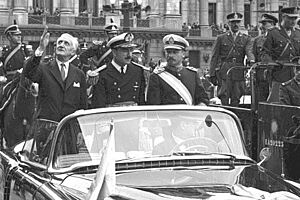
When Arturo Illia became president on October 12, 1963, he aimed for a balanced approach. He was careful because there was always a risk of another military takeover.
One of his first actions was to remove all limits on Peronism and its related political parties. This surprised and angered some in the military. After a military takeover in 1955, Peronist gatherings were banned. However, just five days after Illia took office, a Peronist event took place in Buenos Aires without any problems. Illia also allowed Peronists to take part in the 1965 elections. He also lifted bans on the Communist Party of Argentina and other groups. In April 1964, he introduced a law against discrimination and racial violence.
At home, Illia continued some of the previous president's policies, like public works. But he focused more on social issues and on helping Argentina's own economy, rather than relying too much on foreign money. This was especially clear in his energy policy.
The newspaper La Nación later wrote that it was "not easy to find a president more criticized and attacked" than Illia during his time in office. Yet, he remained "calm and prudent."
Oil Policy
During his election campaign, Arturo Illia promised to change the oil contracts made by the previous government. He believed these contracts were not fair to Argentina. On November 15, 1963, President Illia canceled these contracts. He said they were "illegitimate and harmful to the rights and interests of the Nation."
The previous government had given foreign companies the right to explore for oil. The state oil company, Yacimientos Petrolíferos Fiscales (YPF), had to take all the risks of finding new oil. Illia argued that this was bad for Argentina. He wanted to make sure that Argentina's oil resources benefited the country and its people.
Minimum Wage Law
On June 15, 1964, a very important law was passed: Law 16.459. This law set a minimum wage for the entire country.
The goals of this law were to prevent workers from being exploited and to make sure they earned enough money. It also aimed to improve the income of the lowest-paid workers. To help with these goals, another law was passed to control the prices of basic foods and set minimum standards for pensions.
Education Focus
During Illia's government, education became a top priority. In 1963, 12% of the national budget went to education. This increased to 17% in 1964 and then to 23% in 1965. This was a huge increase!
On November 5, 1964, the National Literacy Plan began. Its goal was to reduce and eventually get rid of illiteracy. At that time, about 10% of adults in Argentina could not read or write. By June 1965, this program had 12,500 learning centers. It was helping more than 350,000 adults of all ages learn to read and write.
Economic Growth
Arturo Illia's economic policies focused on managing the government's money well. He worked to lower the country's debt to other nations. He also strongly supported the growth of Argentine industries.
There were some disagreements with business owners and labor unions. Business owners were unhappy when he canceled oil contracts with foreign companies. They also disliked the law that froze the price of medicines.
Despite these challenges, Argentina's economy grew significantly. Between 1964 and 1965, the country's total economic output (GDP) increased by about 10% each year.
The country's debt to other nations went down from 3.4 billion dollars to 2.7 billion dollars. The average wages for workers increased by almost 25% by the time he left office. Unemployment also dropped from 8.8% in 1963 to 5.2% in 1966.
Even the middle class benefited. Car sales, for example, jumped from 108,000 in 1963 to 192,000 in 1965. This was a record at the time.
International Relations
Illia's government believed in promoting peace and helping developing countries. He and his foreign minister, Miguel Ángel Zavala Ortiz, often spoke about creating a peaceful world based on fairness. They believed that helping poorer nations develop was key to global peace.
On the day he became president, October 12, 1963, Illia said that peace means giving undeveloped nations the chance to overcome inequality and poverty. He believed that for peace to be worldwide, progress and well-being must also be worldwide.
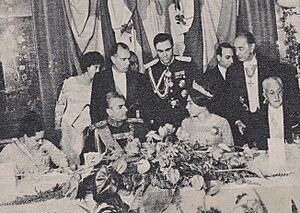
During his presidency, Illia welcomed many important visitors from other countries. These included Charles de Gaulle (President of France), Giuseppe Saragat (President of Italy), Eduardo Frei Montalva (President of Chile), Mohammad Reza Pahlavi (Shah of Iran), and Princess Margrethe (who later became Queen of Denmark).
Public Image and News
During this time, the news media played a big role in how people saw Illia. Many newspapers and journalists criticized him. They said he was slow and not effective. They often showed him as a turtle or with a dove on his head in cartoons. At the same time, they praised military leaders, especially Juan Carlos Onganía. They suggested that the military could bring order to the country.
A campaign against Illia was led by journalists who supported former president Juan Perón, who was in exile. They wanted Perón to return to power. Illia was often shown as timid and lacking energy. In contrast, military leaders were presented as strong figures who could "safeguard the Homeland."
The idea of a military takeover was supported not only by conservative groups but also by the Peronist movement and some labor unions.
The 1966 Coup
On June 28, 1966, a cold winter morning, the military took over the government. Many citizens seemed not to care. The military forced Arturo Illia to leave the presidency and took power themselves.
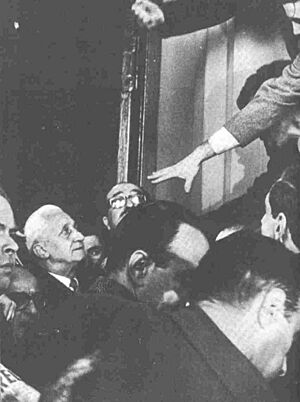
General Julio Rodolfo Alsogaray and other officers came to Illia's office. They asked him to leave the Government House. Illia refused, saying, "I am the commander in chief of the Armed Forces." The military officers left the office. Then, police officers came in with gas launchers, and troops surrounded the Casa Rosada. Illia was asked again to leave. He was told that otherwise, the safety of the people with him could not be guaranteed. Finally, Illia decided to leave.
He walked down the stairs, surrounded by his helpers and many people shouting. He refused a presidential car. He saw his former Minister of Education, Alconada Aramburú, and went with him. They got into Alconada Aramburú's car with seven people inside. They drove to his brother's house in Martínez. The next day, General Juan Carlos Onganía became president. He called this takeover the Argentine Revolution.
Cabinet Members
Illia kept the same cabinet members throughout his presidency. The only change was when Eugenio Blanco passed away. He was replaced by Juan Carlos Pugliese in August 1964.
| Office | Holder | Term |
| President | Arturo Illia | 12 October 1963 – 28 June 1966 |
| Vice President | Carlos Perette | 12 October 1963 – 28 June 1966 |
| Ministry of Foreign Affairs | Miguel Ángel Zavala Ortíz | 12 October 1963 – 28 June 1966 |
| Ministry of Economics | Eugenio Blanco | 12 October 1963 – 4 August 1964 |
| Juan Carlos Pugliese | 4 August 1964 – 28 June 1966 | |
| Ministry of Defense | Leopoldo Suárez | 12 October 1963 – 28 June 1966 |
| Ministry of the Interior | Juan S. Palmero | 12 October 1963 – 28 June 1966 |
| Ministry of Education and Culture | Carlos Alconada Aramburu | 12 October 1963 – 28 June 1966 |
| Ministry of Social Assistance and Public Health | Arturo Oñativia | 12 October 1963 – 28 June 1966 |
| Ministry of Public Services | Miguel Angel Ferrando | 12 October 1963 – 28 June 1966 |
| Ministry of Work and Social Security | Fernando Solá | 12 October 1963 – 28 June 1966 |
Life After Presidency
In September 1966, the same year he was removed from office, Illia's wife, Silvia Martorell, passed away from cancer. For a short time, he lived in Martínez, a suburb of Buenos Aires. However, he often traveled to Córdoba. Illia decided to retire from politics. He went back to Cruz del Eje, Córdoba, where he continued his medical practice. He often treated patients for free as a rural doctor.
Arturo Illia passed away in Cruz del Eje on January 18, 1983, at the age of 82. This was shortly before Argentina became a democracy again. After a public memorial in Congress, Arturo Umberto Illia was buried in La Recoleta Cemetery, in Buenos Aires.
Honoring Illia
The Arturo Umberto Illia House Museum is located at 181 Avellaneda street in downtown Cruz del Eje, in the Córdoba Province. On November 27, 2001, this house was declared a National Historic Monument.
The house is a special and important part of history. It is in the center of Cruz del Eje and truly shows what Arturo Illia was like. It is a typical middle-class house, built in the Art Deco style. It has a balcony above the garage, three bedrooms, a dining room, a bathroom, a kitchen, and a living room.
Awards and Recognition
Arturo Illia received several honors from other countries:
 Chile: Collar of the Order of Merit (October 29, 1965)
Chile: Collar of the Order of Merit (October 29, 1965) France: Knight Grand Cross of the Order of the Legion of Honour (October 1964)
France: Knight Grand Cross of the Order of the Legion of Honour (October 1964) Italy: Knight Grand Cross with collar of the Order of Merit of the Italian Republic (September 8, 1965)
Italy: Knight Grand Cross with collar of the Order of Merit of the Italian Republic (September 8, 1965)
Images for kids
See also
 In Spanish: Arturo Umberto Illia para niños
In Spanish: Arturo Umberto Illia para niños


